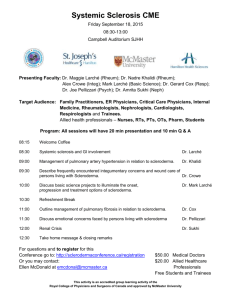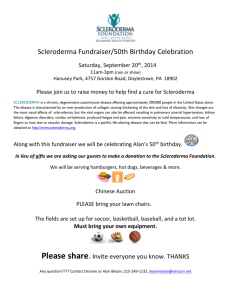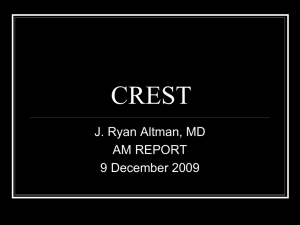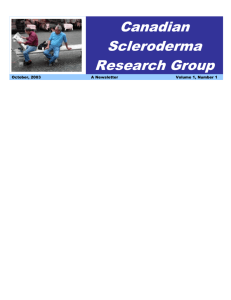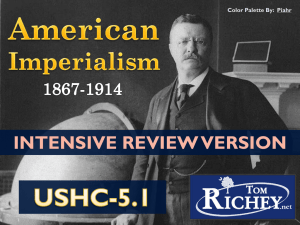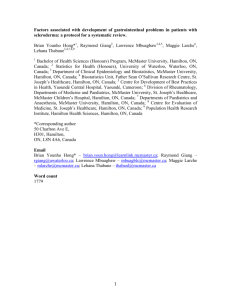dental - jemds
advertisement
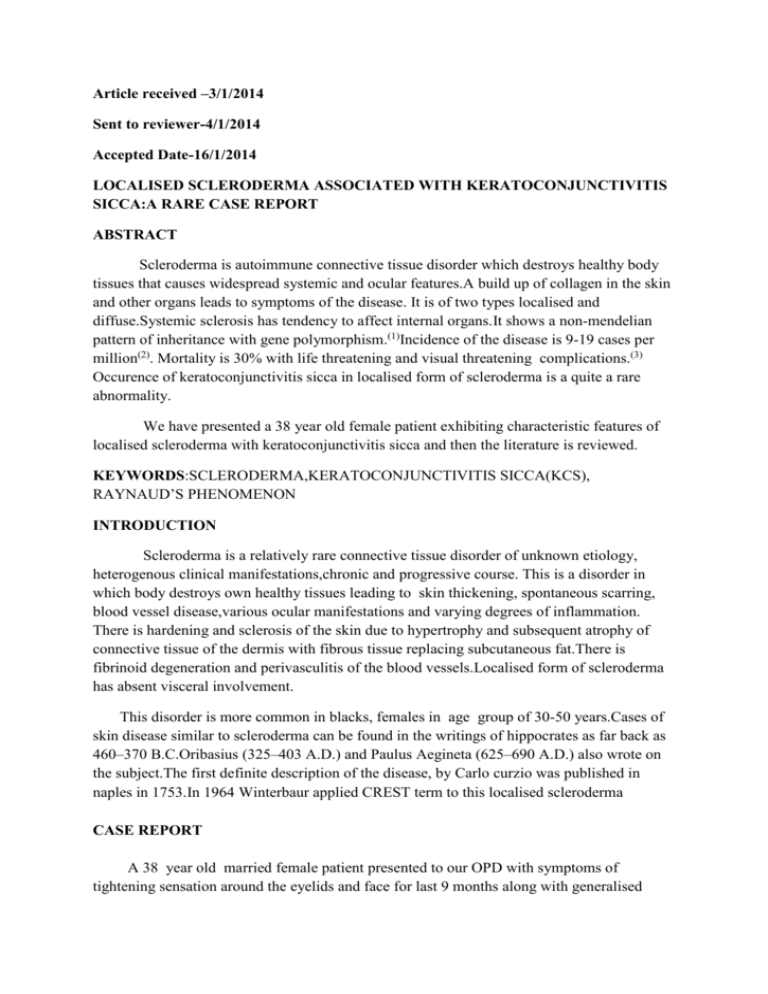
Article received –3/1/2014 Sent to reviewer-4/1/2014 Accepted Date-16/1/2014 LOCALISED SCLERODERMA ASSOCIATED WITH KERATOCONJUNCTIVITIS SICCA:A RARE CASE REPORT ABSTRACT Scleroderma is autoimmune connective tissue disorder which destroys healthy body tissues that causes widespread systemic and ocular features.A build up of collagen in the skin and other organs leads to symptoms of the disease. It is of two types localised and diffuse.Systemic sclerosis has tendency to affect internal organs.It shows a non-mendelian pattern of inheritance with gene polymorphism.(1)Incidence of the disease is 9-19 cases per million(2). Mortality is 30% with life threatening and visual threatening complications.(3) Occurence of keratoconjunctivitis sicca in localised form of scleroderma is a quite a rare abnormality. We have presented a 38 year old female patient exhibiting characteristic features of localised scleroderma with keratoconjunctivitis sicca and then the literature is reviewed. KEYWORDS:SCLERODERMA,KERATOCONJUNCTIVITIS SICCA(KCS), RAYNAUD’S PHENOMENON INTRODUCTION Scleroderma is a relatively rare connective tissue disorder of unknown etiology, heterogenous clinical manifestations,chronic and progressive course. This is a disorder in which body destroys own healthy tissues leading to skin thickening, spontaneous scarring, blood vessel disease,various ocular manifestations and varying degrees of inflammation. There is hardening and sclerosis of the skin due to hypertrophy and subsequent atrophy of connective tissue of the dermis with fibrous tissue replacing subcutaneous fat.There is fibrinoid degeneration and perivasculitis of the blood vessels.Localised form of scleroderma has absent visceral involvement. This disorder is more common in blacks, females in age group of 30-50 years.Cases of skin disease similar to scleroderma can be found in the writings of hippocrates as far back as 460–370 B.C.Oribasius (325–403 A.D.) and Paulus Aegineta (625–690 A.D.) also wrote on the subject.The first definite description of the disease, by Carlo curzio was published in naples in 1753.In 1964 Winterbaur applied CREST term to this localised scleroderma CASE REPORT A 38 year old married female patient presented to our OPD with symptoms of tightening sensation around the eyelids and face for last 9 months along with generalised stiffness of the skin elsewhere.She also complains of inability to open the mouth fully during the same period.Symptoms pertaining to dry eye like grittiness,foreign body sensation and eye tiredness were evaluated using Mcmonnie’s and OSDI dry eye questionnaire.(4) In the case described above following changes were seen. ON GENERAL AND SKIN EXAMINATION revealed shiny waxy appearance of the face with obliteration of skin folds,bird like facies(photo 1a),pinched beak appearance of the nose(photo 1b), decreased oral aperture(photo 1c),abnormal tautness of the skin with hyperpigmentation (photo 1d),Raynaud phenomenon of the extremities with nail fold infarcts(photo 2a,b,3a).Other clinical signs pertaining to systemic involvement of internal organs was unremarkable thus pointing towards localised scleroderma.(5) OCULAR EXAMINATION (BOTH EYES) 1.Visual acuity(without glasses): Right Eye Left Eye 6/6 6/6 Anterior segment: 1.Loss of plasticity of the lids with difficulty in lid retraction due to thickening of the lids. 2.Absence of lagopthalmos. 3 Punctal ectropion 4.Decreased tear meniscus 5.Conjunctival filaments (dry eye)(photo 4) 6.Corneal filaments(dry eye) (photo 4) 7.Shallow fornices revealing foreshortening 8.Lens normal 9.Fundus examination features suggestive of hypertensive retinopathy was not found thereby ruling out systemic involvement of the disease(photo 5a,5b). Other features like peripheral ulcerative keratitis,cataract,glaucoma,vitreous body frost,papilloedema were absent. Right Eye Left Eye TEAR MENISCI 0.2mm 0.2mm TBUT 4sec 4sec SCHIRMER’S <10 <10 RBT positive positive (staining of filaments) (PHOTO 4) INVESTIGATIONS 1.ROUTINE BLOOD INVESTIGATIONS.(TLC,DLC ESR) 2.ECG- NORMAL 3.URINE ROUTINE- NORMAL 4.RENAL FUNCTION TESTS- NORMAL 5.AUTOANTIBODY(ANTI SCL 70)- NEGATIVE 6.SKIN BIOPSY- Section studied shows epidermis and dermis(photo 6a,6b). A. Epidermis lined by stratified squamous epithelium with mild hyperkeratosis. B. Dermis composed of structure collagen bundles and adipose tissue. C. Mild lymphoplasmacytic infiltrate is seen between collagen bundles and around adnexal structures. DISCUSSION Though etiology remains inconclusive still genetic, environmental factors and occupational risk factors have been quoted like human cytomegalovirus,human parvovirus B19,toxic oil syndrome,drugs pentazocine,bleomycin,cyclophosphamide.(6,7,8,9) Autoantibodies to extracellular matrix microfibrillar protein fibrillin 1 has been found in patients of localised scleroderma leading to skin collagen changes with thickening.(10)Further studies have implicated fibroblast responsible for increased collagen production in localised scleroderma.Studies have proved telangiectasia with capillary abnormalities and Raynaud’s phenomenon playing a role in scleroderma.(11) Scleroderma is classified as localized and widespread (systemic sclerosis with a tendency to affect internal organs).Two forms diffuse and limited cutaneous based on the skin involvement. Diffuse is associated with progressive skin induration which starts in the fingers ascending from the distal to proximal involving face and trunk.It causes early fibrosis. Limited has associated with long standing Raynaud’s phenomenon.It is slowly progressive limited to fingers(sclerodactyly),distal extremities and face,not involving trunk.Subset of patients have CREST syndrome. Cardinal features of the syndrome involves vasculopathy,cellular and humoral autoimmunity,progressive visceral and vascular fibrosis in multiple organs. Pathology includes autoantibodies---causes vascular injury---release of endothelin--obliterative vasculopathy---tissue hypoxia---ultimately fibrosis.(12,13) Role of CD4+ CD8+,B and T cells,activated monocyte,macrophages leading to release of cytokines and chemokines that leads to abnormal fibroblast activation which causes fibrosis of the organs,fibrosis and inflammation of conjunctival glands that leads to defective vasculogenesis.(14) Pathology hallmarks include combination of widespread capillary loss and obliterative vasculopathy of small arterioles with fibrosis of skin and internal organs.multiple genetic loci is suspected.(15,16) SYSTEMIC EFFECTS Cardiac effusions and serositis.lunfg fibrosis.esophageal fibrosis .kidney nephritis were absent pointing to the localised nature of the disease. MANAGEMENT Diagnosis and management of keratoconjunctivitis sicca(KCS) is a must in all cases.(17,18) Till date there is no proven therapy for the treatment of scleroderma.Symptomatic based management depends upon which organ is involved which constitutes the following. MEDICAL 1.DISEASE MODIFYING AGENTS.—cyclophosphamide and steroids. 2.ANTIFIBROTICS---D-penicillamine,interferon gamma 3.VASCULAR THERAPY—calcium channel blockers 4.GIT-broad spectrum antibiotics SKIN –antihistaminics,prednisolone OCULAR–primarily tear substitutes In addition to above modalities use of hypomellose,hydroxyl methyl cellulose,polyvinyl alcohol,sodium hyaluronidase is prescribed. DENTAL –mouth rinses to replace minerals, floss,visiting dentist for cleaning. SUMMARY A case of 38 year old female patient having localised scleroderma with keratoconjunctivitis sicca has been described.One must look at the psychosocial aspects as scleroderma is a disfiguring disease that alters all aspects of patients quality of life and thus has a deep psychological impact in the patient.Depression and distress about the disfigurement is common and require psychologic counselling and intervention. PHOTO 1A PHOTO1B PHOTO 1C PHOTO 1 D PHOTO 2A PHOTO 2B PHOTO 3A PHOTO 4 Photo 5a right eye fundus Photo 5b left eye fundus photo 6a photo 6b LEGENDS 1A- BIRD FACIES 1B-PARROT BEAK APPEARANCE OF NOSE 1C-MOUTH WITH REDUCED ORAL APERTURE 1D-FOREARM SHOWING HYPERPIGMENTATION 2A AND 2B HANDS SHOWING NAIL INFARCTS 3 FEET SHOWING NAIL INFARCTS 4 SLIT LAMP SHOWING CONJUNCTIVA AND CORNEAL FILAMENTS 5A AND 5B RIGHT AND LEFT FUNDUS 6A AND 6B HISTOPATHOLOGY SLIDE SHOWING SCLERODERMA CHANGES REFERENCES 1.Feghali-Bostwick C et al:Analysis of systemic sclerosis in twins reveals low concordance for disease and high concordance for the presence of antinuclear antibodies.Arthritis Rheum 48:1956,2003. 2.Mayer MD et al:Prevelance,incidence,survival,and desease charecteristics of systemic sclerosis in a large US population.Arthritis Rheum 48:2246,2003. 3.Scussel-Lonzetti L et al:Predicting mortality in systemic sclerosis:Analysis of a cohort of 309 French Canadian patients with emphasis on features at diagnosis as predictive factors for survival.Medicine(Baltimore) 81:154,2002. 4.Rhett M Schiffman et al:Reliability and Validity of the Ocular Surface Disease Index.Arch Ophthalmol.2000;118:615-621. 5.Maricq HR.Capillary abnormalities,raynaud’s phenomenon and systemic sclerosis in patients with localized scleroderma. Arch Dermatol 1992;128:630-2. 6.Taskin DP et al:cyclophosphamide versus placebo in scleroderma lung disease. N Engl J Med 354:2655,2006. 7.Taskin DP et al:Effects of 1-yr cyclophosphamide on outcome at 2years in scleroderma lung diseases.Am j Respi Crit Care Med 176:1026,2007. 8.Kim KH, Yoon TJ,Oh CW,Ko GH,Kim TH.A case of bleomycin induced scleroderma.J Korean Med Sci 1996;11:454-6. 9.Bellman B,Berman B. Localised indurated brown plaques on arms and right buttock:pentazocin induced morphoea.Arch Dermatol1996;132:1366-9. 10.Arnett FC,tan FK,Uzeil Y et al.Autoantibodies to the extracellular matrix microfibrillar protein,fibrillin 1,in patients with localized scleroderma.Arthritis Rheum 1999;42:2656-9. 11.Khahari VM,Sandberg M, Kalimo H,Vuorio T,Vuorio E, Identification of fibroblasts responsible for increased collagen production in localized scleroderma by in situ hybridization.J Invest Dermatol 1998;90:664-70. 12.Shuster S,Raffle EJ,Bottoms E.Quantitative changes in skin collagen in morphoea.Br J Dermatol 1967;79:456-9. 13.Varga J,Abraham D:systemic sclerosis:Aprototypic multisystem fibrotic disorder.J Clin Invest 117:557,2007. 14.Kuwana M et al:Defective vasculogenesis in systemic sclerosis.Lancet 364:603,2004. 15.Milano A et al:Molecular subsets in the gene expression signatures of scleroderma skin.PLoS ONE 3e2696,2008. 16.Whitfield ML et al:Systemic and cell type-specific gene expression patterns in SSc skin.Proc Natl Acad Sci USA 100:12319,2003. 17.Kobak S et al .the frequency of sicca symptoms and sjogren’s syndromein patients.Int J Rheum dis.2013 feb;16(1):88-92. 18. De A F Gomes et al: Evaluation of dry eye signs and symptoms in patients with systemic sclerosis.Graefes Arch clin exp Ophthalmol.2012 jul;250(7):1051-6.
